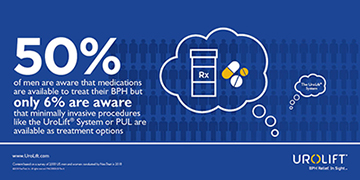Benign Prostatic Hyperplasia (BPH)
Dr. Robert Pugach, Medical Director of Pacific Coast Urology Medical Center, is one of the most experienced urologists in the United States in thermotherapy – a non-surgical treatment for BPH. Thermotherapy can effectively treat your enlarged prostate (BPH) and let you get a good night’s sleep again! You can usually end your dependence on costly medication with its side effects.
Perhaps you have heard the popular commercial, “do you have a going problem” or “do you have a growing problem.” This commercial is talking about one of the most common health problems in men, Benign Prostatic Hyperplasia (BPH), or enlargement of the prostate.
WHAT IS THE PROSTATE?
The prostate gland is located below the bladder and surrounds parts of the urethra. It is basically a gland that allows reproduction to occur. It provides a common channel for the passage of both semen and urine while not allowing the two to mix together. The prostate gland produces some secretions that mix with semen. A normal sized prostate is as small as a walnut and weighs about 15 grams. As the prostate grows (which starts around age 25) it places pressure on the urethra (the tube inside the penis) and prevents a man’s bladder from emptying easily or completely. Since this is a condition of aging, almost all men will have BPH symptoms. Whether they occur at an early age or later in life depends upon several factors, including the prostate growth rate, the ability of a bladder to generate more pressure to compensate for prostate obstruction and a patient’s own anatomy.
WHAT ARE THE SYMPTOMS OF BPH?
BPH places pressure on your urethra and prevents your bladder from functioning normally and/or emptying completely. There are many symptoms and they include:
- Frequent urination, during the day and/or at night
- A slow or weak urine stream
- Dripping or dribbling of urine after urinating
- Incomplete bladder emptying
- A need to urinate quickly and suddenly, possibly resulting in urine leakage
- Painful straining to urinate
- Recurrent, frequent urges to urinate
- A need to wait several seconds – or longer – before urine starts to come out
- Prolonged voiding time
- A need to urinate 2, 3 or more times to empty the bladder
These annoying symptoms can interfere with a man’s quality of life as daily routines often have to be planned around fluid intake and the availability of a bathroom. BPH symptoms can be more than annoying – they can literally control your life! If you have limited the activities you love and can’t get a good night sleep, it’s time to have Dr. Pugach evaluate your BPH symptoms to see if a minimally invasive treatment is right for you.
Here’s an important piece of advice – don’t take BPH symptoms for granted and don’t ignore them! Dr. Robert Pugach advises that, without early treatment, BPH can lead to permanent leakage (urinary incontinence) or the need for a permanent catheter later in life.
WHEN DO MEN BEGIN EXPERIENCING THE SYMPTOMS OF BPH?
Starting around age 25, a prostate starts to enlarge for reasons that are still not known. Statistics show that the risk of BPH symptoms increases every year. BPH is present in:
- 20% of men in their fifties
- 60% of men in their sixties
- 70% of men in their seventies
IS BPH ASSOCIATED WITH PROSTATE CANCER?
It is important that men know that BPH is NOT prostate cancer and having BPH doesn’t mean a man is more or less likely to get prostate cancer. BPH is treatable! (Learn more about prostate cancer and visit our dedicated website)
HOW IS BPH TREATED?
Many primary care physicians and urologists treat BPH symptoms with costly and ineffective medications that may also have adverse side effects for some men.

While medication may be effective for some men, they typically only work in 50% of patients. Effects are usually temporary, because the prostate continues to grow.
Dr. Pugach advises his patients that there are more effective, non-surgical alternatives to medication. These advanced treatment options effectively treat BPH – not just manage the symptoms! The advanced, newer minimally invasive therapies include the use of either microwave or radiofrequency energy to heat the prostate and gently shrink the enlarged tissue. These newer, advanced treatments are:
- In-office 30 minute procedures
- Cause little to no bleeding
- Result in improved urination in most men
- Two to three times as effective as medication
- In most cases allow you to return to normal activities the next day
At Pacific Coast Urology’s BPH Center of Excellence, Dr. Pugach specializes in minimally invasive treatments for BPH and has provided more of them than any other urologist in the western United States. He helped bring this technology to California and teaches procedures to physicians throughout the United States. His teaching activities have also taken him as far as China! View patient videos and read comments.
If you are experiencing BPH symptoms there’s no need to suffer any longer. Don’t continue to limit the activities you love! Please call for more information on Benign Prostatic Hyperplasia (BPH). At Pacific Coast Urology’s BPH Center of Excellence we can help!
Learn more about minimally invasive BPH treatments by clicking on the links below:
For men who are experiencing mild BPH symptoms, talk to Dr. Pugach about medication management. Read Dr. Pugach’s March 2019 article, “Do BPH Medications Cause Dementia and Depression?”
Most of Pacific Coast Urology Medical Center’s minimally invasive BPH therapies are covered by Medicare and most major insurers.
Schedule a consultation today! Call: 888-735-4336





